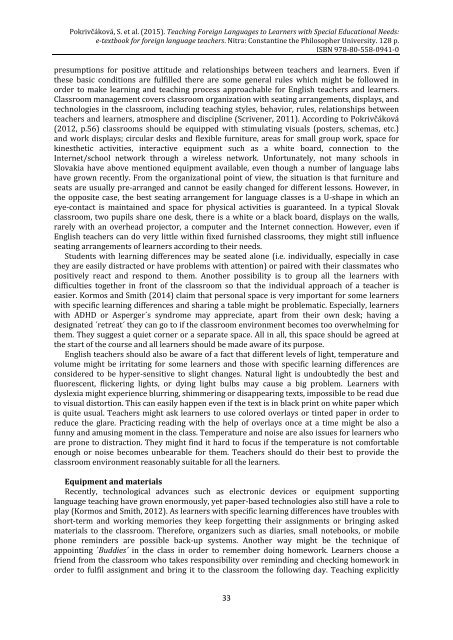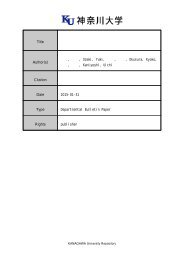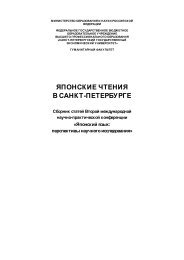to Learners with Special Educational Needs
e-textbook SEN
e-textbook SEN
Create successful ePaper yourself
Turn your PDF publications into a flip-book with our unique Google optimized e-Paper software.
Pokrivčáková, S. et al. (2015). Teaching Foreign Languages <strong>to</strong> <strong>Learners</strong> <strong>with</strong> <strong>Special</strong> <strong>Educational</strong> <strong>Needs</strong>:<br />
e-textbook for foreign language teachers. Nitra: Constantine the Philosopher University. 128 p.<br />
ISBN 978-80-558-0941-0<br />
presumptions for positive attitude and relationships between teachers and learners. Even if<br />
these basic conditions are fulfilled there are some general rules which might be followed in<br />
order <strong>to</strong> make learning and teaching process approachable for English teachers and learners.<br />
Classroom management covers classroom organization <strong>with</strong> seating arrangements, displays, and<br />
technologies in the classroom, including teaching styles, behavior, rules, relationships between<br />
teachers and learners, atmosphere and discipline (Scrivener, 2011). According <strong>to</strong> Pokrivčáková<br />
(2012, p.56) classrooms should be equipped <strong>with</strong> stimulating visuals (posters, schemas, etc.)<br />
and work displays; circular desks and flexible furniture, areas for small group work, space for<br />
kinesthetic activities, interactive equipment such as a white board, connection <strong>to</strong> the<br />
Internet/school network through a wireless network. Unfortunately, not many schools in<br />
Slovakia have above mentioned equipment available, even though a number of language labs<br />
have grown recently. From the organizational point of view, the situation is that furniture and<br />
seats are usually pre-arranged and cannot be easily changed for different lessons. However, in<br />
the opposite case, the best seating arrangement for language classes is a U-shape in which an<br />
eye-contact is maintained and space for physical activities is guaranteed. In a typical Slovak<br />
classroom, two pupils share one desk, there is a white or a black board, displays on the walls,<br />
rarely <strong>with</strong> an overhead projec<strong>to</strong>r, a computer and the Internet connection. However, even if<br />
English teachers can do very little <strong>with</strong>in fixed furnished classrooms, they might still influence<br />
seating arrangements of learners according <strong>to</strong> their needs.<br />
Students <strong>with</strong> learning differences may be seated alone (i.e. individually, especially in case<br />
they are easily distracted or have problems <strong>with</strong> attention) or paired <strong>with</strong> their classmates who<br />
positively react and respond <strong>to</strong> them. Another possibility is <strong>to</strong> group all the learners <strong>with</strong><br />
difficulties <strong>to</strong>gether in front of the classroom so that the individual approach of a teacher is<br />
easier. Kormos and Smith (2014) claim that personal space is very important for some learners<br />
<strong>with</strong> specific learning differences and sharing a table might be problematic. Especially, learners<br />
<strong>with</strong> ADHD or Asperger´s syndrome may appreciate, apart from their own desk; having a<br />
designated ´retreat´ they can go <strong>to</strong> if the classroom environment becomes <strong>to</strong>o overwhelming for<br />
them. They suggest a quiet corner or a separate space. All in all, this space should be agreed at<br />
the start of the course and all learners should be made aware of its purpose.<br />
English teachers should also be aware of a fact that different levels of light, temperature and<br />
volume might be irritating for some learners and those <strong>with</strong> specific learning differences are<br />
considered <strong>to</strong> be hyper-sensitive <strong>to</strong> slight changes. Natural light is undoubtedly the best and<br />
fluorescent, flickering lights, or dying light bulbs may cause a big problem. <strong>Learners</strong> <strong>with</strong><br />
dyslexia might experience blurring, shimmering or disappearing texts, impossible <strong>to</strong> be read due<br />
<strong>to</strong> visual dis<strong>to</strong>rtion. This can easily happen even if the text is in black print on white paper which<br />
is quite usual. Teachers might ask learners <strong>to</strong> use colored overlays or tinted paper in order <strong>to</strong><br />
reduce the glare. Practicing reading <strong>with</strong> the help of overlays once at a time might be also a<br />
funny and amusing moment in the class. Temperature and noise are also issues for learners who<br />
are prone <strong>to</strong> distraction. They might find it hard <strong>to</strong> focus if the temperature is not comfortable<br />
enough or noise becomes unbearable for them. Teachers should do their best <strong>to</strong> provide the<br />
classroom environment reasonably suitable for all the learners.<br />
Equipment and materials<br />
Recently, technological advances such as electronic devices or equipment supporting<br />
language teaching have grown enormously, yet paper-based technologies also still have a role <strong>to</strong><br />
play (Kormos and Smith, 2012). As learners <strong>with</strong> specific learning differences have troubles <strong>with</strong><br />
short-term and working memories they keep forgetting their assignments or bringing asked<br />
materials <strong>to</strong> the classroom. Therefore, organizers such as diaries, small notebooks, or mobile<br />
phone reminders are possible back-up systems. Another way might be the technique of<br />
appointing ´Buddies´ in the class in order <strong>to</strong> remember doing homework. <strong>Learners</strong> choose a<br />
friend from the classroom who takes responsibility over reminding and checking homework in<br />
order <strong>to</strong> fulfil assignment and bring it <strong>to</strong> the classroom the following day. Teaching explicitly<br />
33






